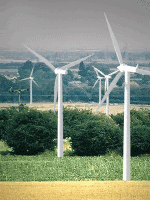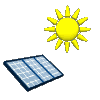
Renewable Energy.
Renewable energy is energy that is obtained from a sustainable source. This means that the source won't be depleted by the process of harnessing the energy. It contrasts with nonrenewable energy sources, such as fossil fuels, which will eventually be entirely consumed.


Geothermal energy is energy that emits from the earth. It comes from magma and the radioactive decay of uranium, thorium, and potassium.
Magma is hot because of the tremendous amount of friction and pressure to be found in the earth's subsurface area.While geothermal energy is massive in total, doesn't do too well when compared to the amount of energy we get from the sun, which wins by a factor of about 20,000. Nevertheless, this energy is tapped by over 20 countries, most notably Iceland, which gets 17% of its electricity from geothermal energy.
The largest geothermal energy plants output a couple hundred MW (megawatts). The process of extracting power from the heat in the earth is pretty simple. You pump water through pipes to the source of the heat and let it boil, the stream runs a turbine which gathers power, then the water is recondensed and sent through the cycle again.
If we had pipes strong enough and deep enough, we could send them down to the earth's mantle and have a practically inexhaustible source of electricity. But with today's technology, we can only reach pockets of heat that are close to the surface.
Geothermal energy is not a strictly renewable energy source like wind or hydro, because the ground cools down slowly as energy is extracted from it. Nevertheless, it does slowly renew thanks to radioactive heating.
It is thought that molten rock at temperatures between 1,200 and 2,200°F (650 to 1,200°C) can be found in pockets 50 to 60 miles (about 80 to 97 km) underneath the earth's surface, just beneath the tectonic plates.
This would provide a prodigious source of geothermal energy, but the deepest hole mankind has drilled only extends about 8 miles (13 km) down. As we move towards independence from fossil fuels, geothermal will join solar and nuclear energy in providing clean power to the world's offices, industries, and homes.
How Does Wind Energy Work?
When we think of wind what comes to your mind: a nice summer breeze, taking a drive with the top down, getting a refreshing gust from your portable fan on a warm day? The truth is the power of wind can provide a vital key to unlocking the means to finding alternative forms of energy.But what’s the deal with alternative energy, anyway? We have a vague idea that these types of enhanced natural resources can save our planet, but we also have heard that alternative energy may have some disadvantages that may not be as talked about as they should be. The fact is alternative energy encompasses a myriad of sub-topics that include water, geothermal, biofuel, nuclear, and solar energy.This page on benefits-of-recycling.com offers some interesting facts about how wind can help with environmental issues like sustainability and global warming.
How Does Wind Energy Work /
Looking at its different sides…Wind is one of the most versatile elements on Earth. It can be light and gentle, cherishing and saving us from burning hot sun, but it can also reveal its other face, uprooting trees and destroying buildings.
The wild energy of wind always captivated humans, and they did and still do their best if not to get control over wind than at least to use its unbridled power for their own purposes.It was wind that helped sea-men cross oceans on their sailing vessels; it was wind that helped our ancestors to turn wheat grain into flour; and now it is wind, that helps us to produce electricity in one of the most natural and environmentally friendly way.
How Does Wind Energy Work / Where Wind Comes From Generally speaking, wind is nothing but a movement of air over the surface of our planet. In order to find out what makes the air move let us recall a little bit of school physics. When the sun shines, it warms everything on Earth, including air; but the key is that the sun does not warm everything equally.
Consequently, there are multiple areas with different temperatures of air. For example, in California it is always much warmer than in Alaska, and, furthermore, during a day the air above the water (sea or lake) is always lower than the temperature of air above the land.According to the laws of physics, hot air always moves up, creating some “vacant places” for air from colder area to move in. When the air masses move from one place to another, we feel the wind.
By the way, the speed of air movement or wind velocity depends on the difference of air pressure: the bigger the difference is – the higher the wind velocity is.At the coastlines it is always windy because of the difference in air pressure above the land and water. That is the reason why many wind power plants are located at the coastline.How Does Wind Energy Work / How Wind Generates Electricity In order to understand how wind power is turned into electricity, let us recall a simple windmill, commonly used in the past by millers to grind seeds and grains into flour. In fact, the principle of work of old windmill and modern wind machines are pretty much similar. Both have blades, which are rotated by the power of wind.The only basic difference is that instead of the millstone, the blades of modern wind machines move the huge turbines, which convert kinetic energy of wind into electric energy.Nowadays, horizontal-axis wind turbines are most widely used.
These machines look like huge but slim windmills: an electric generator with blades is mounted on top of a very high tower. Wind machine towers need to be as high as it is possible in order to catch the wind with highest velocity and thus generate as much electricity as possible.Modern wind machines are very “clever” devices, equipped with gear box for transforming slow rotation of the blades into quicker rotation of the generator and wind sensors, which point the blades right into the wind every time when it changes its direction. The sizes of wind machines vary greatly – from tiny turbines for powering one building and to huge wind machines with height of 198 meters and diameter of 126 meters. A group of wind machines is usually called a wind farm.How Does Wind Energy Work / A Bit of Wind Economy Nowadays, wind energy as the method of transforming wind power into electricity is gaining popularity around the world. Statistically, wind already produces about 1.5% of the electricity, consumed in the whole world, but this share is growing constantly, and we already have countries, such as Germany, Spain and Denmark, which respectively receive 7%, 11% and 19% of the total electricity needs from clean and safe wind farms.In order to better illustrate the prospects and potential of wind energy, let me bring a bit of statistics here: according to official data the global power consumption from all available energy sources is equal to 15 TW per year, and the amount of energy, which can potentially be generated by wind power only, is 75 TW.
How Does Wind Energy Work / The Future The popularity of wind energy grows rapidly not only among environmentalists; it has already been recognized in governmental and business circles as an alternative energy source with high effectiveness and economic potential. The point is that wind represents virtually an unexhausted source of power. It belongs to renewable energy resources, just like solar or geothermal energy. When electricity is generated with the help of wind, it does not harm air, water or soil.Of course, the use of wind energy still provides enough space for further development and improvement. The cost of wind-generated electricity still remains higher than the cost of electricity generated from conventional energy sources. However, this industry develops rapidly, and there is no doubt that in the nearest future wind may transit from alternative into major source of energy.
How Does Wind Energy Work / Sourceshttp://en.wikipedia.org/wiki/Wind_power#Economics_and_feasibilityhttp://www.eia.doe.gov/kids/energyfacts/sources/renewable/wind.html#environmenthttp://www.awea.org/greenpower/http://en.wikipedia.org/wiki/Wind_turbinehttp://eo.ucar.edu/basics/wx_2_c.htmlhttp://www.bwea.com/edu/wind.html

For billions of years the sun has been producing vast amounts of power through nuclear fusion. This is the process by which four hydrogen atoms combine to produce one helium atom.This is the mechanism that the sun uses to generate its energy.The amount of energy from the sun that reaches the Earth is vast. All the energy that can be produced by the non-renewable reserves of the world like petroleum, coal, and natural gas is equaled by just twenty days of sunshine.
What is Solar Energy /
The Power of the SunIf measured outside of our atmosphere the energy that reaches Earth has about 1,300 watts per square meter. This energy is in radiant form and about a third of it is reflected back into space. A certain amount is absorbed by the atmosphere which is the primary cause of weather.Ultimately the energy that reaches the surface of the Earth averages out to about 1,000 watts per square meter on a cloudless day. Of course some arid and desert areas receive more. This means that on a 24-hour day the energy that reaches earth is equivalent to one barrel of oil every year per square meter.These numbers stand for the maximum energy that reaches the Earth from the sun but current technology allows only a small amount of this energy to be collected and converted to other forms of energy which can be more readily used.What is Solar Energy / Have we used any kind of Solar Energy before?Solar power has been harnessed by humans since ancient times. The technology that has been used to harness solar energy has been evolving since then. Since the use of the oculus at the Parthenon in Rome daylighting techniques have been used by ancient architects. Natural light has been dominant method in the history of lighting.During the industrial revolution the use of coal had increased steadily and has shifted from wood and other kinds of biomass to fossil fuels. In the 1860’s there was the expectation that coal would soon be exhausted as a power source so there was research conducted into solar power. However during the early part of the 20th century the development and research of solar power slowed and stopped because of the increasing availability and cost effectiveness of coal and petroleum at the time.In 1973 during the oil embargo and the 1979 energy crisis there was a review and reorganization of energy policies around the world and especially in the industrialized countries. This brought new life to solar power research and development of solar power technologies.
What is Solar Energy /
The FutureThe technologies used in harnessing solar power are on the verge of rapid growth and development in the 21st century. Architects and engineers are increasingly aware of the advantages of building in passive solar power into their designs.The cost of solar water heaters is becoming increasingly competitive with more conventional water heaters in certain areas. Photovoltaic technology is slowly becoming a cheap way of generating electricity.What is Solar Energy / Ending Our Addiction to Fossil FuelOf course the expansion of solar power industry will encounter some problems but these can be overcome. In spite of difficulties put up by some utilities for grid connected photovoltaic systems there will be increased use of these technologies and solar power will be increasingly crucial in ending our addiction to fossil fuels and fighting the threat of global warming and assuring a future based on renewable and clean energy.Sourceshttp://www.epa.gov/RDEE/energy-and-you/affect/non-hydro.htmlhttp://www.epa.gov/RDEE/energy-and-you/affect/non-hydro.html#solarhttp://yosemite.epa.gov/opa/admpress.nsf/ee765cb97fbff562852572a000651fdf/c66cd778dc437bdf852566d70058c32e!OpenDocument
